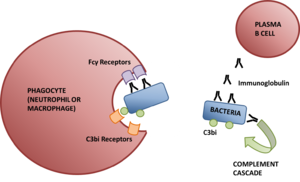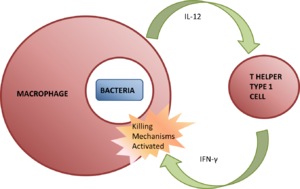Difference between revisions of "Adaptive Immunity to Bacteria"
Rjfrancisrvc (talk | contribs) |
|||
| (13 intermediate revisions by one other user not shown) | |||
| Line 1: | Line 1: | ||
| + | {{OpenPagesTop}} | ||
==Overview== | ==Overview== | ||
The adaptive and [[Innate Immune System|innate responses]] work together to destroy bacteria. The adaptive response ensures the [[Innate Immune System|innate response]] is carried out efficiently. There are two major branches of the adaptive immune response, humoral immunity and cell-mediated immunity. | The adaptive and [[Innate Immune System|innate responses]] work together to destroy bacteria. The adaptive response ensures the [[Innate Immune System|innate response]] is carried out efficiently. There are two major branches of the adaptive immune response, humoral immunity and cell-mediated immunity. | ||
| + | |||
| + | [[File:Adaptive Immunity to Extracellular Bacteria.png|thumb|right|300px|Adaptive Immunity to Extracellular Bacteria - R.J.Francis, RVC 2012]] | ||
==Humoral== | ==Humoral== | ||
| Line 8: | Line 11: | ||
==Cell-Mediated== | ==Cell-Mediated== | ||
| − | Cell-mediated immunity provides help for macrophages. It includes [[Immunoglobulin G|IgG]] production (T-helper type II ( | + | Cell-mediated immunity provides help for macrophages. It includes [[Immunoglobulin G|IgG]] production (through T-helper type II (T<sub>H</sub>2) cell interaction with [[Lymphocytes#B Cells|B cells]]), which improves phagocytosis by opsonisation. Infected [[Macrophages|macrophages]] are rescued by T-helper type I (T<sub>H</sub>1) cells when phagocytosis and digestion mechanisms fail to eliminate the pathogen. |
==Extracellular Infection== | ==Extracellular Infection== | ||
| − | The response to extracellular infection involves [[Complement|complement]] and phagocytosis; [[Lymphocytes#B Cells|B cell]] and T | + | The response to extracellular infection involves [[Complement|complement]] and phagocytosis; [[Lymphocytes#B Cells|B cell]] and T<sub>H</sub>2 cell stimulation and the production of [[Immunoglobulin M|IgM]], which activates the classical cascade. T<sub>H</sub>17 stimulation also enhances extravasation of [[Neutrophils|neutrophils]] to the area to clear the pathogen. There is also class switching of [[Immunoglobulin M|IgM]] to [[Immunoglobulin G|IgG]], which is a good opsonin and targets bacterial Fcγ receptor expressed by [[Macrophages|macrophages]] and [[Neutrophils|neutrophils]]. |
==Vesicular Infection== | ==Vesicular Infection== | ||
| Line 20: | Line 23: | ||
<big>'''Also see [[Immunity to Bacteria]]'''</big> | <big>'''Also see [[Immunity to Bacteria]]'''</big> | ||
| + | [[File:Adaptive Immunity to Intracellular Bacteria.png|thumb|right|300px|Adaptive Immunity to Vesicular Bacteria - R.J.Francis, RVC 2012]] | ||
<br><br> | <br><br> | ||
{{Jim Bee 2007}} | {{Jim Bee 2007}} | ||
| + | |||
| + | {{OpenPages}} | ||
[[Category:Adaptive Immune System]] | [[Category:Adaptive Immune System]] | ||
Latest revision as of 16:13, 2 July 2012
Overview
The adaptive and innate responses work together to destroy bacteria. The adaptive response ensures the innate response is carried out efficiently. There are two major branches of the adaptive immune response, humoral immunity and cell-mediated immunity.
Humoral
Humoral immunity includes complement activation of the classical pathway. It results in the production of IgM and IgG and makes the complement system more efficient.
Cell-Mediated
Cell-mediated immunity provides help for macrophages. It includes IgG production (through T-helper type II (TH2) cell interaction with B cells), which improves phagocytosis by opsonisation. Infected macrophages are rescued by T-helper type I (TH1) cells when phagocytosis and digestion mechanisms fail to eliminate the pathogen.
Extracellular Infection
The response to extracellular infection involves complement and phagocytosis; B cell and TH2 cell stimulation and the production of IgM, which activates the classical cascade. TH17 stimulation also enhances extravasation of neutrophils to the area to clear the pathogen. There is also class switching of IgM to IgG, which is a good opsonin and targets bacterial Fcγ receptor expressed by macrophages and neutrophils.
Vesicular Infection
During a vesicular infection, the infected macrophage secretes IL-12. IL-12 stimulates T-helper type I cells which release IFN-γ. IFN-γ then triggers the macrophages to kill the pathogens inside.
Also see Immunity to Bacteria
| Originally funded by the RVC Jim Bee Award 2007 |
Error in widget FBRecommend: unable to write file /var/www/wikivet.net/extensions/Widgets/compiled_templates/wrt6949d391a6a407_74321757 Error in widget google+: unable to write file /var/www/wikivet.net/extensions/Widgets/compiled_templates/wrt6949d391b42bd5_67683802 Error in widget TwitterTweet: unable to write file /var/www/wikivet.net/extensions/Widgets/compiled_templates/wrt6949d391c17e09_56061299
|
| WikiVet® Introduction - Help WikiVet - Report a Problem |

